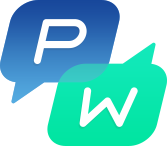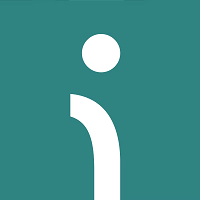Best Push Notification Services Providers
Best push notification services exist Factoreal, PushAlert, OneSignal, Amazon Simple Notification Service, and Pushwoosh. These push notification platforms enable websites or applications to send important notifications to the user's devices.



No Cost Personal Advisor
List of 20 Best Push Notification Services
Contenders | 2024
Single Notification API for All Channels (SMS, Sla
SuprSend offers a scalable notification infrastructure for sending workflow-based transactional notifications, running CRONs, and engagement campaigns. Every notification API channel included (SMS, Slack, Whatsapp, Email, Push, and App Inbox). Read SuprSend Reviews
Explore various SuprSend features, compare the pricing plans, and unlock the potential of seamless operations by selecting the right software for your business.
Features
View all SuprSend Features- Lead Management
- High Volume Processing
- Data Capture
- Mailing list management
- Product Ratings / Reviews
- Revenue Management
- Mobile Notifications
- CAN SPAM Compliance
Pricing
Free Plan
$ 0
Per Month
Growth Plan
$ 99
Per Month
Enterprise Plan
$ 200
Per Month
SuprSend Caters to
- StartUps
- SMBs
- Agencies
- Enterprises
Emergents | 2024
One of the leading push service providers in the market
OneSignal is among the well-known push notification providers that aid companies in connecting with their customers effectively. Its user-friendly interface and powerful features enable the easy distribution of personalized messages across many platforms. OneSignal is among the push notification tools that help businesses stay connected and increase user engagement by providing targeted promotions or alerting customers. Learn more about OneSignal
Explore various OneSignal features, compare the pricing plans, and unlock the potential of seamless operations by selecting the right software for your business.
Features
View all OneSignal Features- Campaign Segmentation
- Analytics
- A/B Testing
- Expiry Notifications
- Notification Scheduling
- Contextual Targeting
- Web Notifications
- Visual Notifications
Pricing
Free
$ 0
Forever
Starter
$ 99
Per Month
Pro
$ 500
Per Month
OneSignal Caters to
- StartUps
- SMBs
- Agencies
- Enterprises
Emergents | 2024
Services by Srijan Capital
PushEngage is a push notification platform that provides seamless customer and corporate communication. It is among the best notification services that allow businesses to send personalized notifications, boost engagement, and enhance conversions with its user-friendly UI and complex targeting capabilities. The potent features of PushEngage maintain contact with the audience and improve your marketing plan. Learn more about PushEngage
Explore various PushEngage features, compare the pricing plans, and unlock the potential of seamless operations by selecting the right software for your business.
Features
View all PushEngage Features- Web Notifications
- Geo Targeting
- Contextual Targeting
- Visual Notifications
- Expiry Notifications
- Campaign Segmentation
- Analytics
- Mobile Notifications
PushEngage Caters to
- StartUps
- SMBs
- Agencies
- Enterprises
Emergents | 2024
#1 Customer Retention Platform
CleverTap is among the leading push notification software that empowers businesses with personalized and engaging mobile messaging solutions.CleverTap's segmentation and advanced analytics tools provide precision targeting, ensuring that the correct users receive messages at the right moment. It is among the push notification service providers that revolutionize consumer engagement and drives growth and retention for organizations worldwide through seamless platform integration. Learn more about CleverTap
Explore various CleverTap features, compare the pricing plans, and unlock the potential of seamless operations by selecting the right software for your business.
Features
View all CleverTap Features- Website Analytics
- Customer Segmentation
- Cohort Analysis
- Data Import / Export
- Email Marketing
- Funnel Analysis
- Marketing Automation
- Customer Engagement
CleverTap Caters to
- StartUps
- SMBs
- Agencies
- Enterprises
Emergents | 2024
Has served Fortune 500 companies
Without asking any high-cost, Airship helps a business to be stay updated with any of the business moves. This free push notification software can easily acquire and retain customers by sending personalized push notifications based on previous history. Learn more about Airship
Explore various Airship features, compare the pricing plans, and unlock the potential of seamless operations by selecting the right software for your business.
Features
View all Airship Features- Web Notifications
- Contextual Targeting
- Campaign Segmentation
- Notification Schedule
- Notification Scheduling
- Website Notifications
- Device Targeting
- Mobile Notifications
Airship Caters to
- StartUps
- SMBs
- Agencies
- Enterprises
Emergents | 2024
Trusted by 250,000+ developers
Pusher is a well-known push message service that excels at sending messages to web and mobile applications in real-time. Pusher enables developers to integrate push notifications into their applications with its solid infrastructure and user-friendly API. Its dependability, scalability, and various capabilities make it a top option for companies looking to communicate with users effortlessly. Learn more about Pusher
Explore various Pusher features, compare the pricing plans, and unlock the potential of seamless operations by selecting the right software for your business.
Features
View all Pusher Features- Notification Schedule
- Web Notifications
- Website Notifications
- Analytics
- Notification Scheduling
- Mobile Notifications
- Campaign Segmentation
- Contextual Targeting
Pusher Caters to
- StartUps
- SMBs
- Agencies
- Enterprises
Emergents | 2024
One of the push service leaders
Pushwoosh is a highly robust push notification software that offers a complete suite of marketing tools for sending messages. Some of which includes deep linking, multi-language support, conversion tracking, in-app messaging, and more. Learn more about Pushwoosh
Explore various Pushwoosh features, compare the pricing plans, and unlock the potential of seamless operations by selecting the right software for your business.
Features
View all Pushwoosh Features- Notification Scheduling
- A/B Testing
- Website Notifications
- Mobile Notifications
- Campaign Segmentation
Pricing
Free
$ 0
Forever
Basic
$ 42
Per Month
Pro
$ 126
Per Month
Pushwoosh Caters to
- StartUps
- SMBs
- Agencies
- Enterprises
Category Champions | 2024
All-in-one Push message service
WebEngageis a push notification system that provides all-inclusive client interaction solutions. WebEngage allows businesses to deliver tailored push notifications, improving client retention and boosting conversions with its user-friendly design and versatile capabilities. Its analytics capabilities offer insightful data that can be used to improve campaigns, making it a go-to platform for efficient communication techniques. Read WebEngage Reviews
Explore various WebEngage features, compare the pricing plans, and unlock the potential of seamless operations by selecting the right software for your business.
Features
View all WebEngage Features- Web Forms
- Contact Management
- Lead Management
- Marketing Analytics
- Multivariate Testing
- Marketing Automation
- Email Integration
- Campaign Segmentation
Pricing
Free
$ 0
User/Month
WebEngage Caters to
- StartUps
- SMBs
- Agencies
- Enterprises
Contenders | 2024
Up to 40% better push delivery
MoEngage is among the best web push notification services enabling companies to engage and keep customers using their mobile apps. MoEngage provides personalized and timely notifications due to its cutting-edge features and user-friendly design, increasing conversions and patron satisfaction. It is an efficient strategy for sending effective push alerts that produce results. Read MoEngage Reviews
Explore various MoEngage features, compare the pricing plans, and unlock the potential of seamless operations by selecting the right software for your business.
Features
View all MoEngage Features- Funnels
- In-App Events Tracking
- Analytics
- Abandoned Cart Saver
- Consolidated Campaign Statistics
- Intelligent Path Optimizer
- Auto-Responders
- Proactive Assistant
MoEngage Caters to
- StartUps
- SMBs
- Agencies
- Enterprises
Emergents | 2024
Push service to drive more traffic
iZooto is among the push notification companies that assist businesses in interacting with and keeping website visitors on their websites. The intuitive UI and powerful capabilities of iZooto enable the seamless distribution of tailored push notifications, boosting conversion rates and fostering greater client loyalty. It is among the best push notification software for firms looking to communicate effectively with their audience because of its analytics and automation solutions. Learn more about iZooto
Explore various iZooto features, compare the pricing plans, and unlock the potential of seamless operations by selecting the right software for your business.
Features
View all iZooto Features- Mobile Notifications
- Web Notifications
- Analytics
- Expiry Notifications
- Visual Notifications
- Geo Targeting
- Notification Scheduling
- Contextual Targeting
iZooto Caters to
- StartUps
- SMBs
- Agencies
- Enterprises
Contenders | 2024
Innovative marketing automation software
NotifyVisitors is a cutting-edge push mobile notification service that helps businesses engage and retain their audience. With its user-friendly interface and robust features, NotifyVisitors is among the push notification solutions that enable targeted messaging, personalized campaigns, and real-time analytics. Its seamless integration options and comprehensive support make it ideal for businesses looking to boost customer engagement and conversions. Read NotifyVisitors Reviews
Explore various NotifyVisitors features, compare the pricing plans, and unlock the potential of seamless operations by selecting the right software for your business.
Features
View all NotifyVisitors Features- Personalization
- Customer Journey Mapping
- Customer Segmentation
- Surveys & Feedback
- User Journeys
- Custom Integrations
- Web Notifications
- Mobile Notifications
NotifyVisitors Caters to
- StartUps
- SMBs
- Agencies
- Enterprises
Emergents | 2024
Easy A/B testing for every event
Pushbots is among the push notification services with a user-friendly interface and smooth integration. It transforms how companies and their customers communicate. It is among the push notification providers that help users in various ways by sending personalized, timely messages directly to mobile devices. With the platform's cutting-edge technology, you can raise engagement, boost conversions, and maintain contact. Learn more about PushBots
Explore various PushBots features, compare the pricing plans, and unlock the potential of seamless operations by selecting the right software for your business.
Features
View all PushBots Features- Contextual Targeting
- A/B Testing
- Campaign Segmentation
- Web Notifications
- Mobile Notifications
- Visual Notifications
- Analytics
- Notification Schedule
PushBots Caters to
- StartUps
- SMBs
- Agencies
- Enterprises
Emergents | 2024
All-in-one push notification software
Leanplum is a unified mobile marketing platform, which offers an excellent push message service. It lets you build, test, and deliver targeted push notifications based on real-time user behaviors. Plus, it provides a personalized experience across multiple channels. Learn more about Leanplum
Explore various Leanplum features, compare the pricing plans, and unlock the potential of seamless operations by selecting the right software for your business.
Features
View all Leanplum Features- Expiry Notifications
- Visual Notifications
- Push Notifications
- Funnel Analysis
- Geo Targeting
- Contextual Targeting
- Uninstall Tracking
- Analytics
Leanplum Caters to
- StartUps
- SMBs
- Agencies
- Enterprises
Emergents | 2024
Trusted by 5000+ brands
FoxPush is a modern push notification platform that offers frictionless user and corporate communication. FoxPush provides targeted communications, increased engagement, and higher conversion rates with its simple UI and strong features. Companies can utilize the strength of FoxPush's effective push notification solutions to stay ahead of the competition. Read FoxPush Reviews
Explore various FoxPush features, compare the pricing plans, and unlock the potential of seamless operations by selecting the right software for your business.
Features
View all FoxPush Features- Website Notifications
- Analytics
- Campaign Segmentation
- Notification Scheduling
- Contextual Targeting
- Mobile Notifications
- Web Notifications
- Notification Schedule
FoxPush Caters to
- StartUps
- SMBs
- Agencies
- Enterprises
Emergents | 2024
Services by MANAGEBATCH
Batch is among the best push notification services facilitating seamless communication between users and applications. Its powerful features and user-friendly UI enable businesses to engage their audience effectively. This push notification software ensures prompt and targeted delivery of anything from customized notifications to real-time updates, boosting the overall user experience. Learn more about Batch
Explore various Batch features, compare the pricing plans, and unlock the potential of seamless operations by selecting the right software for your business.
Features
View all Batch Features- Segmentation
- Customizable CTAs
- Drip Campaigns
- Visual Notifications
- Analytics/ROI Tracking
- Notification Scheduling
- Contextual Targeting
- Campaign Segmentation
Batch Caters to
- StartUps
- SMBs
- Agencies
- Enterprises
Emergents | 2024
Hyper-personalized mobile push service
Taplytics is among the push notification service providers changing how users connect with mobile apps. With its user-friendly platform, Taplytics allows companies to send users timely, personalized notifications that increase conversions and user retention. It is a popular option for enhancing app performance and maximizing user satisfaction due to its advanced targeting and segmentation features. Read Taplytics Reviews
Explore various Taplytics features, compare the pricing plans, and unlock the potential of seamless operations by selecting the right software for your business.
Taplytics Caters to
- StartUps
- SMBs
- Agencies
- Enterprises
Emergents | 2024
A highly functional push notification software
Kumulos is a top provider of push message services, sending intriguing and pertinent messages to users of mobile apps. Developers can quickly incorporate push notifications into their applications and successfully connect with their audience because of the platform's robustness. The push notification system gives organizations the tools to optimize their mobile marketing efforts with powerful analytics and segmentation features. Learn more about Kumulos
Explore various Kumulos features, compare the pricing plans, and unlock the potential of seamless operations by selecting the right software for your business.
Features
View all Kumulos Features- Analytics
- In-App Events Tracking
- Push Notifications
- Expiry Notifications
- Mobile Notifications
- Cohort Analysis
- Retention Tracking
- Device Targeting
Kumulos Caters to
- StartUps
- SMBs
- Agencies
- Enterprises
Emergents | 2024
Services by PushAssist
PushAssist is among the best push notification services offering organizations seamless interaction. It provides personalized messaging, real-time statistics, and automated campaigns across several platforms with its user-friendly UI and robust features. PushAssist helps businesses to engage their audience effectively and foster meaningful connections, driving conversions and strengthening customer loyalty. Learn more about PushAssist
Explore various PushAssist features, compare the pricing plans, and unlock the potential of seamless operations by selecting the right software for your business.
Features
View all PushAssist Features- Device Targeting
- Campaign Segmentation
- Analytics
- Geo Targeting
- Mobile Notifications
- Visual Notifications
- Notification Scheduling
- Web Notifications
PushAssist Caters to
- StartUps
- SMBs
- Agencies
- Enterprises
Emergents | 2024
Services by Accengage
Accengage is a push message service that gives companies a robust platform to interact with and connect with consumers of their mobile apps. Accengage supports businesses in sending timely and pertinent alerts that increase user engagement and app retention with its advanced targeting capabilities, real-time analytics, and personalized message features. Learn more about Accengage
Explore various Accengage features, compare the pricing plans, and unlock the potential of seamless operations by selecting the right software for your business.
Features
View all Accengage Features- Device Targeting
- Mobile Notifications
- Expiry Notifications
- Campaign Segmentation
- Geo Targeting
- Contextual Targeting
- Notification Scheduling
- Visual Notifications
Accengage Caters to
- StartUps
- SMBs
- Agencies
- Enterprises
Contenders | 2024
Omnichannel marketing automation platform
Omnisend is among the versatile push notification services that revolutionize customer engagement. Its robust features allow businesses to easily build and distribute personalized messages immediately. Omnisend increases conversions and client retention through cart reminders and product updates. For a unique marketing experience, alerts can be automated and integrated easily. Read Omnisend Reviews
Explore various Omnisend features, compare the pricing plans, and unlock the potential of seamless operations by selecting the right software for your business.
Features
View all Omnisend Features- Rules-Based Workflow
- Scheduled Messaging
- Subscribe / Unsubscribe
- Split Testing
- Email Drip Campaigns
- GDPR Compliance
- Campaign Segmentation
- Custom Email Filtering
Pricing
Free
$ 0
Per Month
Standard
$ 16
Per Month
Pro
$ 59
Per Month
Omnisend Caters to
- StartUps
- SMBs
- Agencies
- Enterprises
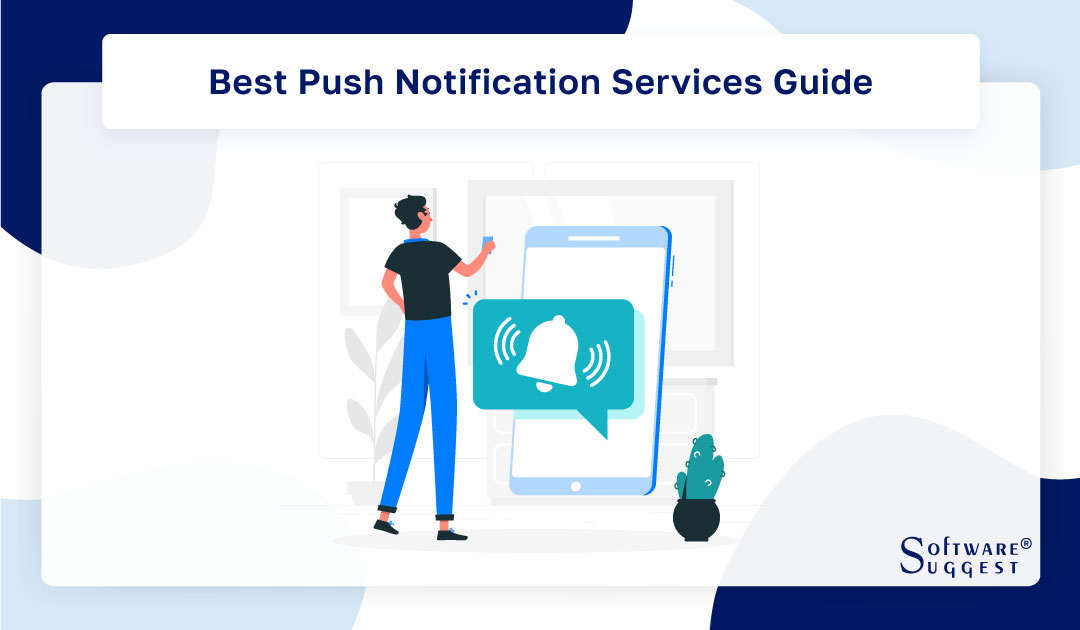
In today's fast-paced digital landscape, staying connected with your audience is crucial for business success. One effective way to engage and retain users is through push notifications.
These powerful tools allow you to deliver timely and personalized messages directly to users' devices, cutting through the noise and capturing their attention. This article will explore the five best push notification services that can help you maximize user engagement and drive conversion rates.
What are Push Notification Services?
Push notification services are specialized platforms or tools that enable businesses to send targeted messages to their app users. These messages are delivered directly to users' devices, appearing as pop-up notifications, even when the app is not actively used. Unlike traditional SMS or email marketing, push notifications offer a real-time and interactive way to engage users, ensuring that your messages reach them instantly.
How do Push Notification Services Work?
To understand how push notification services work, let's break it down into three key steps publication of the app, installation of the app, and transmission of the notification.
The first step involves the publication of the application. Before sending push notifications, you must have an app published on relevant platforms such as the App Store or Google Play Store. This app is the channel through which you'll connect with your audience.
The next step would be the installation of the application. Once your app is available for download, users need to install it on their devices. During installation, users are typically prompted to grant permission for the app to send push notifications. It's essential to provide clear and compelling reasons for users to opt-in to receive these notifications.
The last step would be the transmission of notifications to the app. When you're ready to send a push notification, the push notification service uses a cloud-based infrastructure to transmit the message to the targeted devices. The service leverages unique device identifiers, such as registration or device tokens, to ensure the notification reaches the intended recipients.
Main Benefits of Push Notification Tools
Push notification tools offer a range of benefits that can significantly impact your business's success. Let's explore some of the advantages -
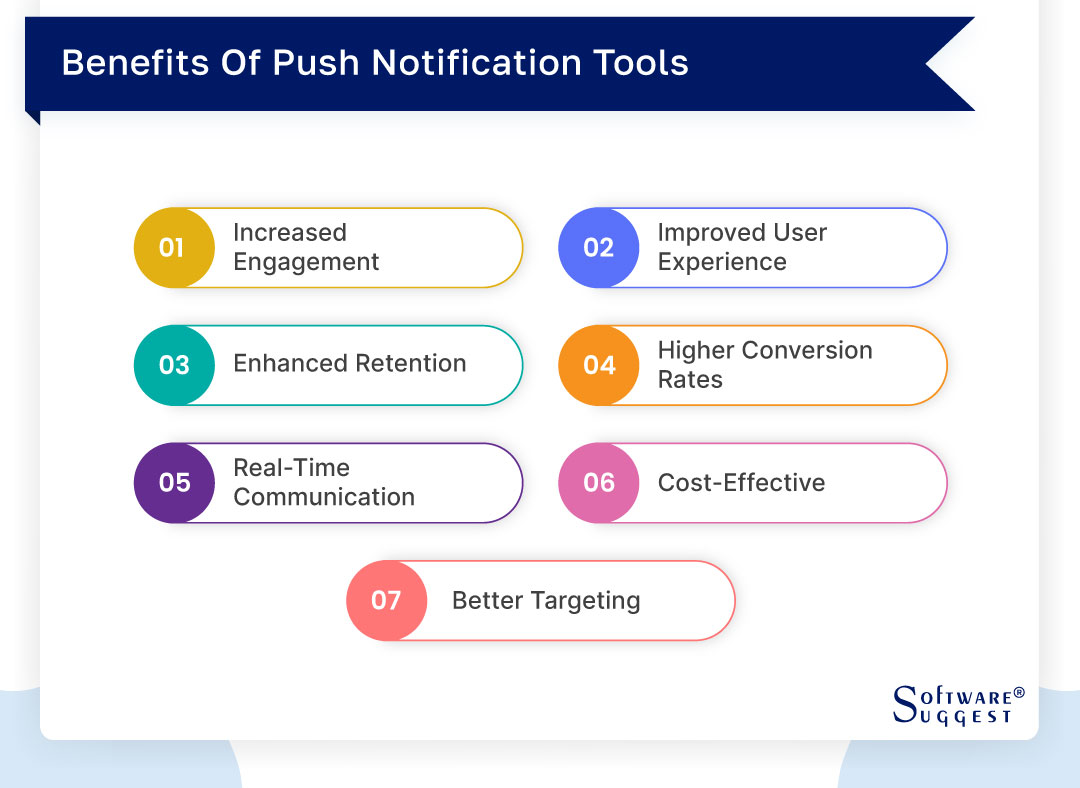
-
Increased engagement
Push notifications serve as a direct communication channel to reach your users. By sending relevant and personalized messages, you can capture users' attention and encourage them to interact with your app or take specific actions, ultimately boosting user engagement.
-
Improved user experience
By delivering push notifications, you enhance the overall user experience. Timely and valuable information can be sent notifying users about important updates, exclusive offers, or relevant content, creating a positive impression of your brand and increasing satisfaction.
-
Enhanced retention
Push notifications play a vital role in retaining users and reducing churn rates. Regularly reminding users about your app and its value keeps them engaged and encourages them to continue using your services. By offering personalized recommendations or incentives, you can further enhance user retention.
-
Higher conversion rates
With well-crafted push notifications, you can drive higher conversion rates by nudging users toward desired actions. Whether making a purchase, completing a registration, or participating in a limited-time offer, push notifications can effectively guide users through the conversion funnel.
-
Real-time communication
One of the key advantages of push notifications is their real-time nature. They enable instant communication with your users, allowing you to deliver time-sensitive information, urgent updates, or live event notifications, fostering a sense of urgency and encouraging immediate action.
-
Cost-effective
Compared to other marketing channels, push notifications are a cost-effective solution. They eliminate the need for printing materials or investing in expensive advertising campaigns. With push notification services, you can reach a large audience at a fraction of the cost, maximizing your ROI.
-
Better targeting
Push notification tools offer advanced targeting capabilities, allowing you to segment your audience based on various criteria such as demographics, behavior, or preferences. This enables you to deliver highly relevant and personalized messages to specific user segments, increasing the chances of engagement and conversion.
Why Do You Need Push Notification Software?
Now that we've explored the benefits of push notifications, let's delve into why you need dedicated push notification software for your business.
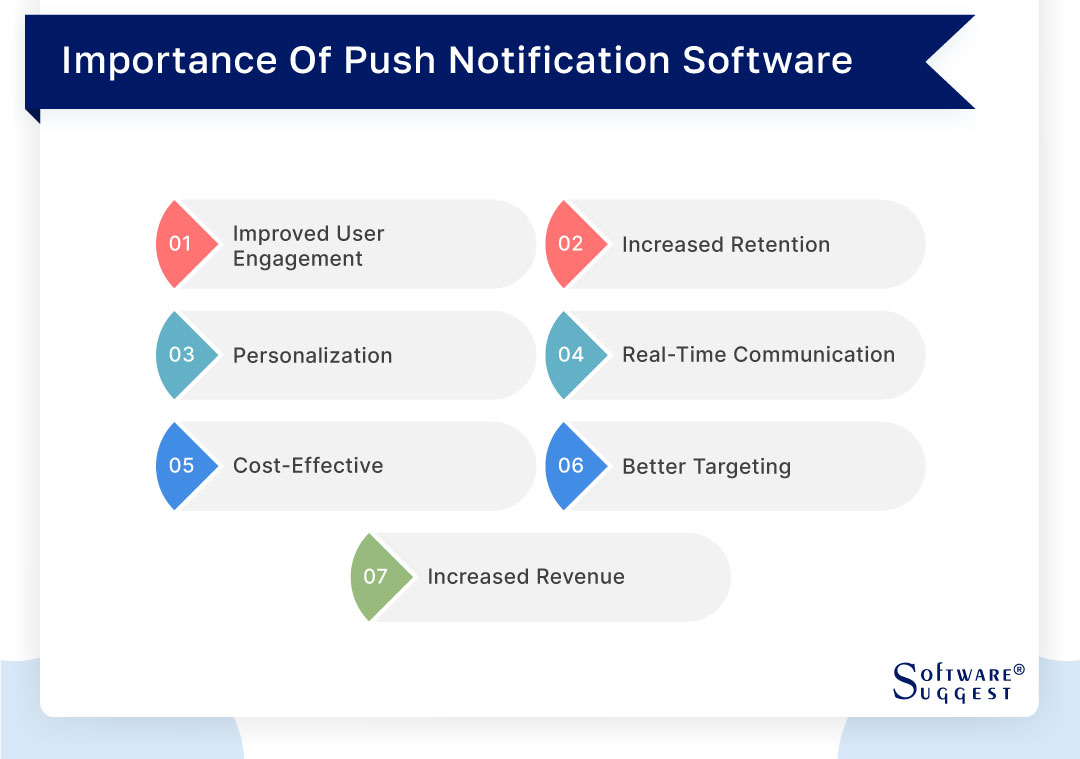
-
Improved user engagement
Push notification software enables you to create and send highly engaging messages that captivate your users. With features like rich media support, interactive elements, and personalized content, you can grab users' attention and encourage them to interact with your app actively.
-
Increased retention
Retaining users is a key challenge for businesses. Push notification software helps address this challenge by allowing you to send relevant and timely reminders, updates, and incentives that keep users coming back to your app. You can foster loyalty and reduce churn rates by nurturing the user relationship.
-
Personalization
Personalized experiences are becoming increasingly important for users. Push notification software empowers you to tailor messages based on user preferences, behavior, and historical data. By delivering personalized content, recommendations, or exclusive offers, you can create a more meaningful and personalized user experience.
-
Real-time communication
In today's fast-paced world, real-time communication is essential. Push notification software lets you instantly reach your users with important information, updates, or time-sensitive offers. This direct and immediate communication channel ensures that your messages are received promptly and acted upon.
-
Cost-effective
Investing in push notification software is a cost-effective marketing solution. Compared to traditional advertising channels, push notifications eliminate the need for printing, distribution, or ad placements. With a single platform, you can efficiently manage and send notifications to a large user base, maximizing your reach without incurring significant expenses.
-
Better targeting
Push notification software offers advanced targeting capabilities that allow you to segment your audience based on various parameters. Whether it's demographics, location, interests, or past behavior, you can precisely target specific user groups with tailored messages, increasing the relevance and effectiveness of your notifications.
-
Increased revenue
Push notification software can directly impact your revenue generation efforts. You can drive conversions and boost sales by leveraging personalized recommendations, limited-time offers, or abandoned cart reminders. Additionally, by promoting upsells, cross-sells, or loyalty programs, you can maximize the lifetime value of your customers.
Who Uses Push Notification Software?
Push notification software is widely used across various industries and sectors. Here are a few examples of businesses that benefit from utilizing push notification services.

-
B2C marketing
Businesses involved in B2C marketing, such as retailers, e-commerce platforms, or service providers, leverage push notification software to engage with their customer base, promote new products, deliver personalized offers, and drive sales.
-
E-commerce
E-commerce businesses rely heavily on push notifications to inform customers about order updates, delivery status, and exclusive deals. Push notifications enable them to provide a seamless shopping experience and drive repeat purchases.
-
Digital publishers
Digital publishers, including news outlets, blogs, and content platforms, utilize push notification software to deliver breaking news and personalized content recommendations and drive traffic to their websites or apps.
-
Travel and hospitality
In the travel and hospitality industry, push notifications are vital in sharing travel updates, flight or hotel booking confirmations, personalized offers, and recommendations for nearby attractions. They enhance the overall travel experience and increase customer satisfaction.
Different Types of Push Notification Services
You can use push notification services to deliver a great user experience. You can use push notifications in sync with other channels to create an omnichannel experience.
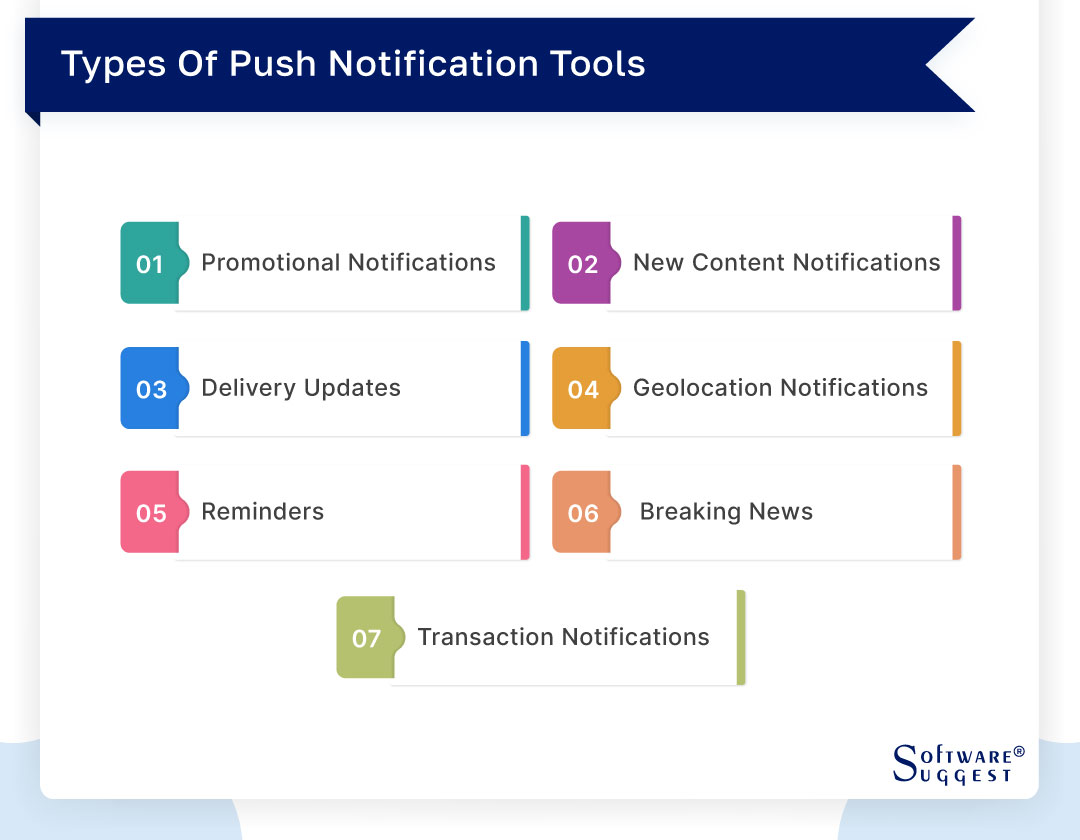
-
Promotional notifications
Promotional push notifications are designed to promote specific products, services, or offers to your user base. They can highlight discounts, limited-time deals, or exclusive promotions, enticing users to take immediate action and make a purchase.
-
New content notifications
These notifications inform users about fresh and relevant content available on your platform, such as new blog posts, articles, videos, or podcasts. By alerting users to valuable updates, you can drive traffic to your website or app, enhance user engagement, and foster a loyal following.
-
Delivery updates
Ideal for e-commerce businesses, delivery update notifications provide real-time information about a user's order status. Keeping customers informed about their package's progress, estimated delivery time, and any delays helps build trust and improves the overall customer experience.
-
Geolocation notifications
Geolocation-based push notifications leverage the user's location data to deliver personalized messages. They can provide location-specific offers, recommendations, or reminders, tailoring the content to the user's current geographical context.
-
Reminders
Push notifications can serve as powerful reminders to help users stay organized and engaged. Reminders can be set for various purposes, such as upcoming appointments, deadlines, events, or even abandoned shopping carts. These timely reminders can prompt users to take action and prevent missed opportunities.
-
Breaking news
For news and media organizations, push notifications effectively deliver breaking news alerts directly to users' devices. Instantly informing users about significant events, developments, or important announcements helps them stay informed and engaged with your content.
-
Transaction notifications
Transaction notifications are sent to users to confirm and provide updates on their completed transactions. Whether it's a purchase confirmation, payment receipt, or booking details, transaction notifications offer the user reassurance, transparency, and a sense of completion.
How to Choose Push Notification Service Providers?
When selecting a push notification service provider, consider the following factors.
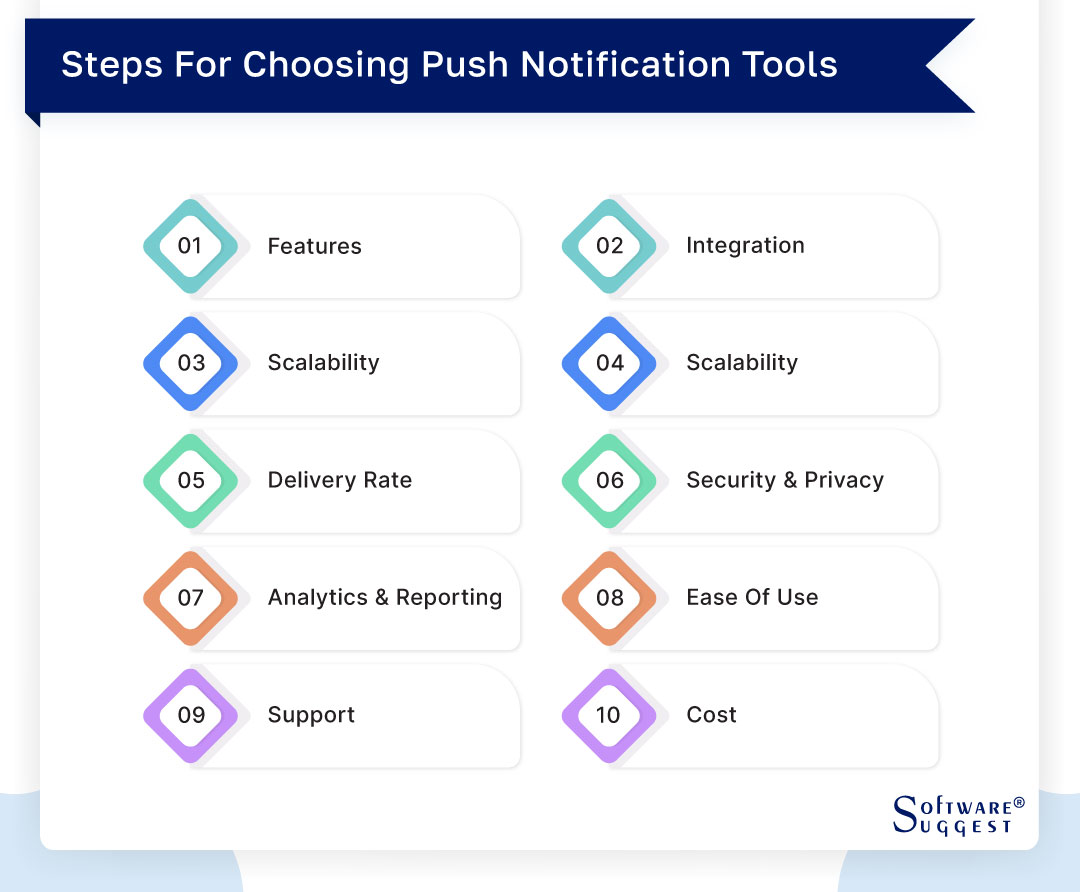
-
Features
Evaluate the features offered by the service provider. Look for capabilities such as segmentation, personalization, automation, rich media support, localization, and targeting options that align with your specific requirements.
-
Integration
Check the compatibility and ease of integration with your existing systems, such as mobile apps, websites, or customer relationship management (CRM) platforms. A smooth integration process ensures seamless communication between your systems and the push notification service provider, enabling efficient data exchange and streamlined workflows.
-
Scalability
Consider the scalability of the service provider's infrastructure. Will they handle your growing user base and increasing notification volumes without compromising delivery speed and performance? Scalability is crucial to accommodate your business's future needs.
-
Delivery rate
A high delivery rate ensures that your push notifications reach their intended recipients promptly. Investigate the service provider's delivery rate track record and their strategies to maintain high delivery rates, such as using reliable delivery channels and monitoring feedback loops.
-
Security and privacy
Safeguarding user data and ensuring privacy is of utmost importance. Evaluate the security measures the push notification service provider implements, including data encryption, secure transmission protocols, and compliance with relevant regulations such as GDPR or CCPA
-
Analytics and reporting
Comprehensive analytics and reporting capabilities are essential for assessing the performance of your push notification campaigns. Look for service providers that offer detailed insights into delivery rates, open rates, click-through rates, conversion rates, and user engagement metrics to help you optimize your strategies effectively.
-
Ease of use
Choose a push notification service provider with a user-friendly interface and intuitive workflows. The ease of use will simplify campaign setup, message creation, audience segmentation, and scheduling, enabling you to manage your notifications efficiently.
-
Support
Reliable customer support is crucial when you encounter technical issues or need assistance with using the service provider's platform. Ensure they offer responsive support channels, such as email, live chat, or phone, and consider their reputation for providing helpful and timely assistance.
-
Cost
Evaluate the pricing structure of the push notification service provider. Consider the number of notifications you anticipate sending, additional features or add-ons, and any contractual commitments. Balance the cost with the value and benefits the service provider offers.
Top 5 Push Notification Services with Pros, Cons, Pricing & Features
|
Name
|
Free Trial
|
Demo
|
Starting Price
|
|---|---|---|---|
| 14-days |
Yes |
Starts at $99/month | |
|
14-days |
Yes | Starting price at $0.01/verification | |
|
7-days |
Yes |
Custom Pricing | |
| 14-days |
Yes |
Starts at $29/month | |
|
14-days |
Yes |
Starts at $9/month |
The top 5 push notification services have earmarked their positions among the best due to their high deliverability, easy templating, and interactive CTAs. Most have a free version you can try before signing up for one.
1. SuprSend
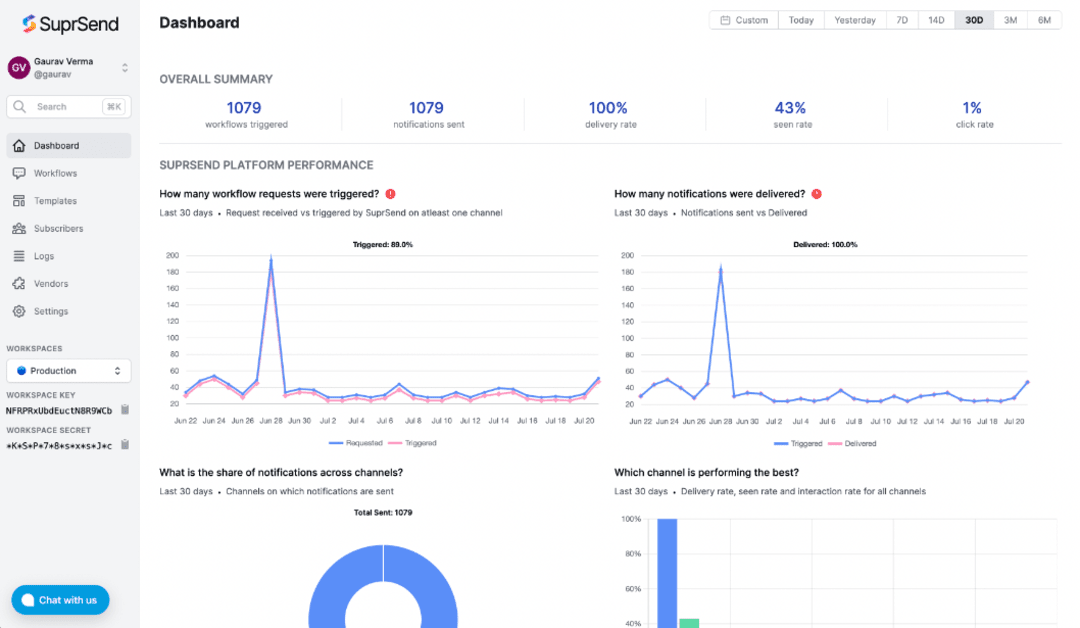
SuprSend is a single notification API to send out your push notifications and other channel notifications that top our list. With their advanced drag-and-drop template configuration options, you can design a notification that best suits your use case. Apart from the ease of designing the notification, you can also track which content works for your users with notification analytics. Just integrate SuprSend into your app and leave aside the technical aspect of handling.
- Integration of Android Service & Receiver
- Advanced Notification configuration for sending all types of notification content
- Handling Notification support for different Android API Level
- Setting up notification tracking in your backend service
- Handling notifications in the background and Foreground mode and much more.
With SuprSend, you can start sending notifications to all the channels (android, ios, web push, sms, email, slack, WhatsApp, app inbox ) with a single API integration. Also, with advanced workflows, you can handle all notification use cases such as CRONs, reminders, digest, multi-lingual messages, etc.
Features
- Easy integration with popular platforms
- Rich message personalization
- Real-time delivery and reporting
- Audience segmentation
- Custom events and triggers
Pros
- Seamless integration with popular platforms and CMSs
- Extensive personalization options for targeted messaging
- Real-time delivery and comprehensive reporting
- Audience segmentation based on user attributes and behavior
- Custom events and triggers for automation
Cons
- Limited advanced features compared to larger providers
- Some users may require more in-depth documentation
- Pricing plans may not be suitable for all budget ranges
- Limited customer support options
- Additional costs for certain add-ons and services
Pricing
- SuprSend offers a free plan with 10000 notifications. Paid plans start at $99/month/ 25000 notifications, with higher-tier plans available for more extensive needs.
2. Google Firebase

Google Firebase is a comprehensive mobile development platform with a powerful push notification service. It offers seamless integration with other Firebase products and scalability for growing businesses.
Features
- Cross-platform support
- Real-time delivery
- Notification composer
- Targeted messaging
- Performance management
Pros
- Tight integration with other Firebase products and Google services
- Easy setup and integration process for newer teams
- Scalable infrastructure for developers to grow with the business
- Real-time delivery for all notifications leading to a good UX experience
- Free plan available for startups looking to experiment initially
Cons
- Lack of advanced automation features
- Limited customization options for notification appearance
- Support primarily through community forums and documentation
- Complex pricing structure for Firebase's broader services
- Limited support for web push notifications
Pricing
Firebase offers a free plan (Spark Plan) and a pay-as-you-go plan (Blaze Plan). Module pricing details for the Blaze Plan are outlined below.
- Authentication - starts at $0.01/verification
- Cloud Firestore - starts at $0.18/GiB
- Hosting - starts at $0.026/GB
- Realtime Database - $5/GB for storage, $1/GB for downloaded data
- Storage - $0.026/GB (stored), $0.12/GB (downloaded)
- Test Lab - $1/device/hour for virtual test, $5/device/hour for physical test
3. Leanplum
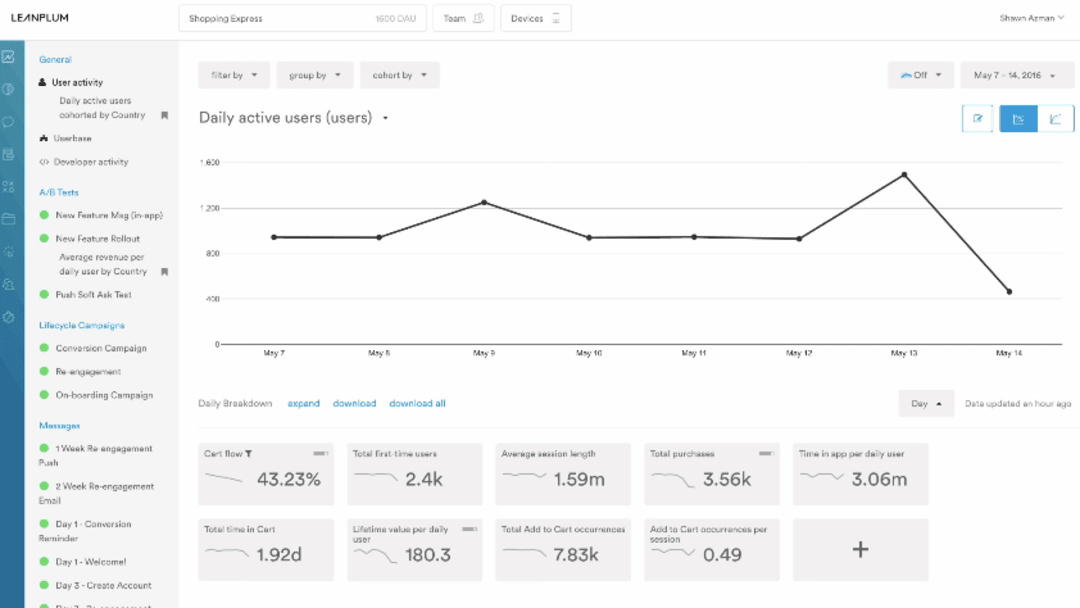
Leanplum is a push notification service that delivers personalized and data-driven engagement campaigns. It empowers businesses with advanced targeting capabilities and comprehensive user insights. Their A/B testing can help you improve your CTR rate with iterations in the copies, delivery times, and frequency.
Features
- AI-powered automation
- Behavioral triggers
- In-app personalization
- A/B testing and optimization
- User segmentation
Pros
- Advanced personalization and automation capabilities
- Behavioral triggers for targeted notifications
- In-app personalization for a customized user experience
- A/B testing
- Dynamic user segmentation
Cons
- Learning curve for setting up and utilizing advanced features
- Higher pricing compared to some other providers
- Limited support for certain platforms
- Some users may find the interface overwhelming
- Support resources primarily available through documentation
Pricing
- Leanplum offers custom pricing based on business requirements and scale. Contact their sales team for detailed pricing information.
4. PushBots

PushBots is a push notification service that offers real-time analytics and multi-language support to help businesses engage with their audiences effectively. With features like scheduled and recurring notifications, geolocation targeting, and customizable templates, PushBots provides a comprehensive solution for businesses of all sizes.
Features
- Real-time analytics
- Multi-language support
- Scheduled and recurring notifications
- Geolocation targeting
- Customizable templates
Pros
- Real-time analytics for tracking campaign performance
- Multi-language support for global reach
- Scheduled and recurring notifications for automation
- Geolocation targeting for location-specific messaging
- Customizable templates for branded notifications
Cons
- Limited platform support compared to some competitors
- Some users may find the interface outdated
- Advanced features available only on higher-tier plans
- Integration with certain platforms may require additional effort
- Limited customer support options
Pricing
PushBots offers various pricing plans, starting from $29/month/ 5k subscribers, with custom enterprise plans available.
5. OneSignal
OneSignal is a leading push notification service known for its comprehensive functionality and ease of use. With robust features and extensive platform support, it caters to businesses of all sizes. They also support personalization which is a must to have in the push notification category.
Features
- Personalization
- Advanced analytics
- Automated messaging
- A/B testing
Pros
- Easy integration and setup process for every tech team member
- Extensive platform support for tech teams
- Robust segmentation options for providing a differentiated user experience
- Rich analytics and reporting capabilities
- Free plan available for new startups looking to start
Cons
- Some advanced features require a paid subscription
- Limited customization options for push notification templates
- Documentation could be more comprehensive
- Pricing plans can be expensive for larger subscriber counts
- Limited customer support on the free plan
Pricing
OneSignal offers a range of pricing plans, including a free tier for up to 10,000 recipients. Paid plans start at $9/month, with custom enterprise solutions available.
How to Implement a Push Notification Software?
Discover the steps to implement push notification software in your system. You can also bypass the manual integration process by leveraging pre-built push notification infrastructure tools like SuprSend.
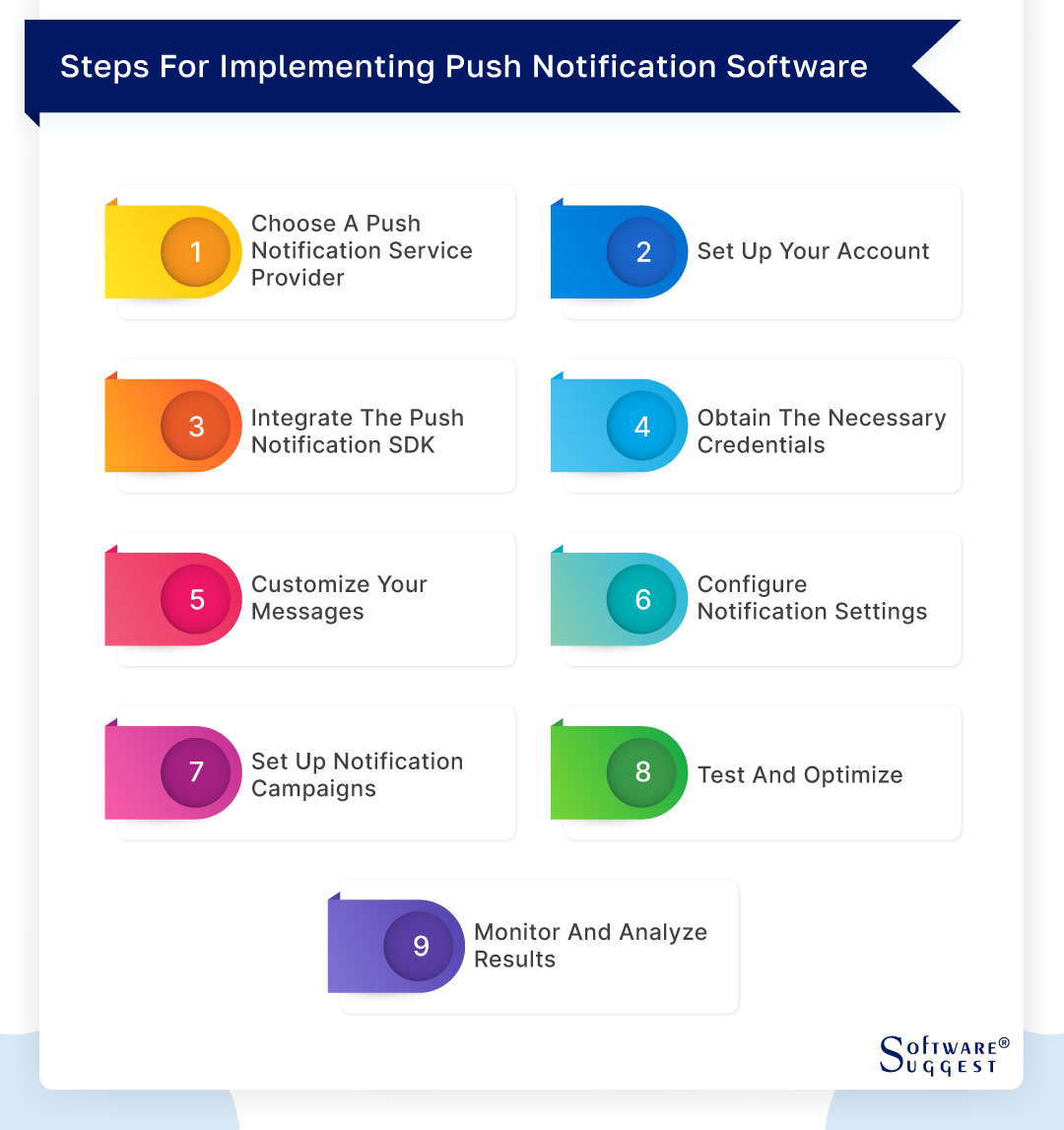
-
Choose a push notification service provider
Selecting the right push notification service provider is the initial step toward establishing a robust notification system. Many providers offer diverse features, scalability options, and pricing plans. Analyze your business requirements, consider target audience size, budget, and desired functionalities, and opt for a service provider that aligns with your needs.
-
Set up your account
Once you have chosen a push notification service provider, creating an account is the next logical step. Sign up on their platform and provide the necessary information to register your account successfully. Take note of any unique identifiers or keys provided during this process, as they will be required for integration and authentication purposes.
-
Integrate the push notification SDK
To enable seamless communication between your application and the push notification service, integrating the Push Notification Software Development Kit (SDK) is vital. The SDK facilitates the transmission of push notifications to your users' devices. The service provider typically offers comprehensive documentation and guides to assist you with the integration process.
-
Obtain the necessary credentials
During the integration process, you must obtain specific credentials from the push notification service provider. These credentials, such as API keys, authentication tokens, or device tokens, are essential for establishing a secure and authenticated connection between your application and the push notification service.
-
Customize your messages
Crafting compelling and personalized push notification messages is crucial for capturing users' attention and driving engagement. Leverage the customization options provided by the service provider's platform to tailor your messages according to user preferences, demographics, and behavior. Incorporate persuasive language, vivid imagery, and a clear call to action to entice users to interact with your notifications.
-
Configure notification settings
Fine-tuning your notification settings allows you to control your push notifications' timing, frequency, and delivery preferences. Strike the right balance between timely updates and avoiding notification fatigue by optimizing delivery time, time zones, and frequency capping settings. Ensure your settings align with your target audience's preferences to maximize the impact of your notifications.
-
Set up notification campaigns
Notification campaigns provide a structured approach to push notification distribution. Plan and design targeted campaigns based on user segments, events, or actions. Tailor your notifications to user journey stages, such as onboarding, conversion, or retention. Implement A/B testing to gauge the effectiveness of different campaign strategies and iterate accordingly.
-
Test and optimize
Thoroughly testing your push notification platform is crucial before launching any campaigns. Verify notifications delivery, appearance, and functionality across various devices, operating systems, and browsers. Pay attention to formatting, images, deep linking, and interactive elements. Continuously optimize your notifications based on user feedback, performance analytics, and industry best practices.
-
Monitor and analyze results
Once your push notification campaigns are live, monitoring and analyzing the results is essential for evaluating their effectiveness. Monitor key performance metrics such as click-through rates, conversion rates, and user engagement.
Leverage our push notification service provider's analytics and reporting features to gain insights into user behavior, campaign performance, and the overall impact on your business objectives. Identify patterns, trends, and opportunities for improvement. Use this data-driven approach to refine your push notification strategy, make informed decisions, and achieve better results.
Challenges in Push Notification Services
Following are the challenges in push notification services. The challenges can be mitigated by using the below-mentioned points leading to a satisfactory push notification experience.
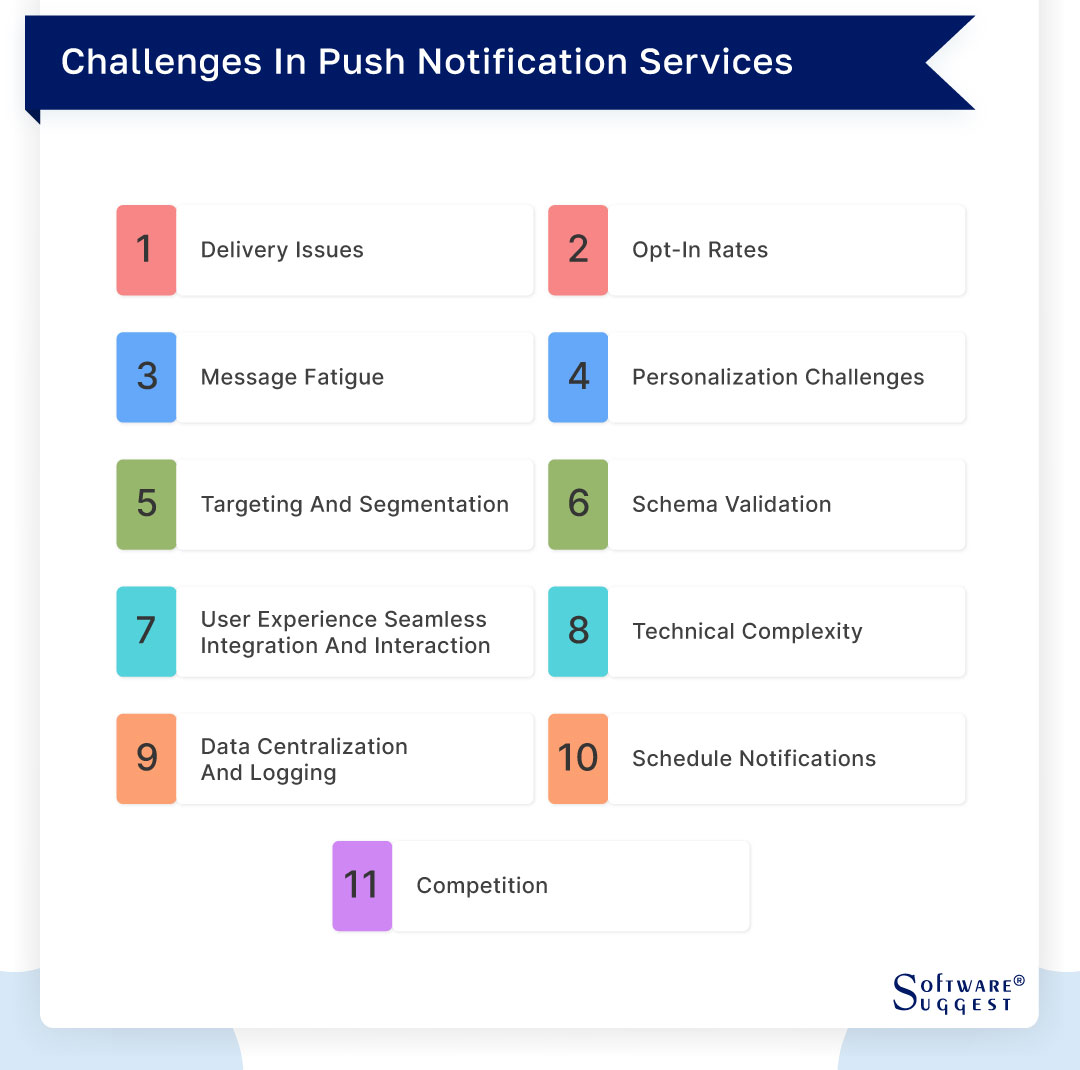
-
Delivery issues
Regarding push notifications, delivery issues can arise due to various factors such as network connectivity, device limitations, and platform-specific restrictions. Push notification providers must employ robust infrastructure and leverage reliable delivery protocols to ensure messages reach users promptly and consistently across multiple platforms and devices. Some providers like SuprSend provides logs for each notification delivery using a unique temporal ID that can be viewed later on the dashboard.
-
Opt-in rates
Obtaining user opt-ins is crucial for any push notification campaign. However, convincing users to subscribe can be a significant challenge. Push notification providers must employ persuasive techniques and offer compelling value propositions to entice users to opt in. This may involve highlighting exclusive offers, personalized content, or useful updates that users can receive by subscribing to push notifications.
-
Message fatigue
Sending too many push notifications can lead to message fatigue, causing users to become disengaged or even opt out altogether. Push notification providers must strike the right balance between providing valuable information and not overwhelming users with excessive notifications. Crafting a well-defined strategy that considers user preferences, relevance, and frequency of notifications is key to combating message fatigue.
-
Personalization challenges
Personalization plays a crucial role in the success of push notifications. However, tailoring messages to individual users can be complex, especially when dealing with a large user base. Push notification providers must employ advanced algorithms and machine learning techniques to analyze user behavior, preferences, and historical data to deliver highly personalized and relevant notifications that resonate with each user.
-
Targeting and segmentation
Effectively targeting and segmenting users is essential to maximize the impact of push notifications. Push notification providers must offer robust segmentation capabilities, allowing businesses to define specific user groups based on demographics, behavior, and other relevant factors. Businesses can increase user engagement and conversion rates by delivering targeted notifications to the right audience.
-
Schema validation
Push notification providers must address the challenge of schema validation to ensure that notifications are displayed consistently across various platforms and devices. Validating notification schemas helps maintain a uniform user experience and ensures that the intended message is effectively conveyed, regardless of the user's device or operating system.
-
User experience seamless integration and interaction
The user experience is of utmost importance when it comes to push notifications. Providers should focus on delivering seamless integration of notifications within the user interface of the device or application. Additionally, interactive notifications allowing users to perform actions directly from the notification enhance engagement and convenience.
-
Technical complexity
Behind the scenes, push notification providers must manage complex backend infrastructure to handle message routing, delivery, and analytics. Dealing with large-scale message queues, real-time data processing, and system scalability requires technical expertise and robust infrastructure to ensure reliable and efficient push notification services.
-
Data centralization and logging
To optimize push notification campaigns, providers must centralize and log data related to user interactions, delivery rates, and engagement metrics. Analyzing this data helps businesses gain valuable insights into user behavior, preferences, and campaign performance, enabling them to refine their strategies and deliver more effective notifications.
-
Schedule notifications
Determining the optimal time to send push notifications is crucial for maximizing their effectiveness. Push notification providers should offer scheduling capabilities that allow businesses to time their notifications based on user behavior patterns and preferences. By analyzing historical data and leveraging machine learning algorithms, providers can recommend the most opportune moments to send notifications, ensuring higher open and engagement rates.
-
Competition
With the increasing popularity of push notifications, the competition among businesses to capture users' attention is fierce. Push notification providers must continually innovate and differentiate their services to help businesses stand out. This includes offering unique features, advanced personalization options, and integrations with other marketing channels to provide a comprehensive and cohesive user experience.
Best Practices of Push Notification Services
Following are the best practices associated with sending push notifications. You can follow the best practices to deliver a great notification experience.
-
Timing is key
Timing plays a crucial role in the success of your push notification campaigns. Delivering notifications at the right moment ensures maximum user attention and engagement. Consider user time zones, preferences, and behaviors to schedule notifications strategically.
-
Make the desired action the most prominent
To drive the desired response from users, it's essential to make the intended action clear and prominent within the notification. Craft concise, persuasive messages that motivate users to take the desired action with a single tap.
-
Be clear and concise
Push notifications have limited space, so conveying your message concisely and clearly is crucial. Opt for succinct language that captures attention and provides a quick overview of the value or information you want to deliver.
-
Personalize the message
Personalization enhances user engagement and improves the chances of converting notifications into meaningful actions. Leverage user data, such as their preferences, location, or past interactions, to tailor messages to their interests and needs.
-
Keep your messages to a polite number
Bombarding users with excessive notifications can lead to annoyance and user fatigue. Find the balance between staying relevant and avoiding overwhelming users. Respect the user's attention and send notifications sparingly and selectively.
-
Automate your notifications
Leverage automation tools and capabilities offered by push notification service providers to streamline your campaigns. Set up triggered notifications based on user behavior, events, or predefined conditions to ensure timely and relevant communication.
-
Send onboarding messages
Onboarding messages are an excellent opportunity to guide users through your app's features or highlight the value they can gain from your service. Use push notifications to welcome new users, provide helpful tips, or encourage them to complete specific actions to enhance their experience.
-
Provide value
Every push notification should offer some form of value to the recipient. Whether it's a special offer, personalized content, or relevant information, ensure that your notifications provide a compelling reason for users to engage and interact with your app or website.
-
Respect user preferences
Respecting user preferences and allowing them to customize their notification settings is vital for building trust and maintaining a positive user experience. Provide clear options for users to opt in or out of specific notifications, ensuring that you honor their choices.
-
Test and optimize
Continuously testing and optimizing your push notifications is key to improving their effectiveness. Conduct A/B tests to compare different variations of messages, timing, and targeting parameters. Analyze the results and refine your strategies to maximize engagement and conversion rates.
Current Trends in Push Notification Systems
Push notification market is witnessing a new change in how the push notification experiences are delivered. Check out the below trends happening in push notification system.
-
Automated push notifications
Automation is revolutionizing the way push notifications are delivered. Push notification providers are incorporating artificial intelligence (AI) and machine learning algorithms to automate sending personalized and contextually relevant notifications based on user behavior, preferences, and real-time events. This trend enables businesses to engage with their users in a more targeted and timely manner.
-
Interactive notifications
Interactive notifications enable users to take action directly from the notification itself without opening the app. Push notification providers leverage interactive elements such as buttons, forms, and quick replies to facilitate user engagement and streamline the user experience. This trend allows businesses to drive conversions and increase user interaction without requiring users to navigate multiple screens.
-
Artificial Intelligence (AI)
AI is playing a significant role in the evolution of push notifications. Push notification providers use AI algorithms to analyze user data, predict user behavior, and deliver highly personalized notifications. AI-powered systems can automatically adapt to user preferences, optimize delivery timing, and generate dynamic content tailored to each user, resulting in more impactful and effective notifications.
-
Rich media notifications
Rich media notifications incorporate images, videos, GIFs, and other visual elements to enhance the overall user experience. Push notification providers are expanding their capabilities to support rich media notifications, enabling businesses to deliver visually appealing and engaging content directly to users' devices. This trend helps capture users' attention and drive higher levels of engagement and interaction.
-
Location-based notifications
Location-based notifications leverage geolocation data to send targeted messages to users based on their physical proximity to specific locations or points of interest. Push notification providers integrate geofencing and beacon technologies to deliver hyper-localized and contextually relevant notifications. This trend enables businesses to send personalized offers, updates, or recommendations based on users' real-time locations, enhancing the effectiveness and relevance of their notifications.
-
Instant Apps
Instant apps allow users to interact with an app's functionality without the need for installation. Push notification providers are embracing this trend by enabling businesses to send notifications that deep link directly to specific app features or content, even if the app is not installed on the user's device. Instant apps provide a frictionless user experience and can drive higher app adoption rates by allowing users to engage with app content seamlessly.
-
In-app messaging
In-app messaging is a trend where push notification providers can send notifications within the app itself, rather than relying solely on traditional push notifications. This allows businesses to engage users while using the app, providing real-time updates, personalized recommendations, or interactive messages. In-app messaging enhances user engagement, improves retention rates, and facilitates ongoing communication between businesses and their users.
-
Cross-Channel Integration
Push notification providers recognize the importance of cross-channel integration to create a unified user experience. This trend involves integrating push notifications with other marketing channels like email, SMS, social media, and chat apps. By synchronizing messaging across multiple channels, businesses can deliver consistent and coordinated communications, ensuring that users receive the right message at the right time through their preferred channels. Cross-channel integration enhances the overall user experience and increases the chances of user engagement and conversion.
-
Privacy and Security
In an increasing concern about data privacy and security, push notification providers must prioritize user trust and data protection. They should implement robust security measures to safeguard user information and comply with relevant regulations such as GDPR (General Data Protection Regulation) and CCPA (California Consumer Privacy Act). Transparent opt-in and opt-out mechanisms, encryption protocols, and secure data storage practices are essential for maintaining user trust and privacy.
Conclusion
Push notification services present both challenges and opportunities for businesses. Overcoming delivery issues, optimizing personalization, and striking the right balance in frequency and timing is crucial for effective push notification campaigns.
By staying ahead of the current trends, including automated notifications, interactive features, AI-driven personalization, and cross-channel integration, businesses can leverage the full potential of push notifications to engage users, drive conversions, and enhance the overall user experience. Prioritizing user trust and privacy is equally important to ensure long-term success in utilizing push notifications as a powerful marketing tool.
FAQs
The average push notification open rate can vary depending on various factors such as industry, user demographics, and the message's relevance. However, industry benchmarks suggest a good open rate for push notifications is 15% to 25%. It's important to note that optimizing factors like personalization, timing, and message relevance can positively impact the open rate.
To ensure the effectiveness of push notifications, consider the following tips
- - Personalize messages based on user preferences and behavior.
- - Deliver notifications at the optimal time for each user.
- - Keep messages concise, relevant, and actionable.
- - Test and analyze different notification strategies to optimize engagement.
- - Leverage automation and AI to deliver timely and personalized notifications.
- - Respect user preferences and provide easy opt-out options.
Maintaining user trust and privacy is crucial for successful push notification campaigns. Here are some best practices to follow
- - Obtain user consent and provide clear opt-in/opt-out options.
- - Securely handle and protect user data following industry best practices.
- - Comply with relevant privacy regulations, such as GDPR and CCPA.
- - Be transparent about the data collected and how it is used.
- - Provide value to users through relevant and useful notifications.
- - Allow users to customize their notification preferences.
The number of push notifications to send depends on the nature of your business, user preferences, and the relevance of the messages. Avoid overwhelming users with excessive notifications, leading to message fatigue and increased opt-outs. Strive for a balanced approach by sending notifications that provide value and meet the needs of your users without being excessive or intrusive.
The best time to send a push notification varies depending on your target audience and the nature of your message. Analyzing user behavior and engagement patterns is important to determine your target audience's optimal timing. According to a report by SuprSend, the best time to send push notifications are usually during working hours, like 10 am to 12 pm or 2 pm to 4 pm, as that’s when the user is using the device and would likely check the notifications.








